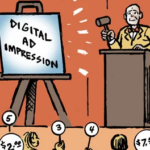 AwesomenessTV, which was purchased by DreamWorks Animation in 2013 for $33 million, is racing to reach teen audiences and capture more brand dollars in the Gen-Z gold rush. Those born in the mid ’90s-early 2000s, that is.
AwesomenessTV, which was purchased by DreamWorks Animation in 2013 for $33 million, is racing to reach teen audiences and capture more brand dollars in the Gen-Z gold rush. Those born in the mid ’90s-early 2000s, that is.
With more than 2 million followers and 1 billion video views per month, AwesomenessTV is generally regarded as one of YouTube’s more successful multichannel networks, and the company has attracted several waves of external investment.
Last December, Hearst Corp. took a 25% stake in the company, which is now valued at $325 million. Following this investment, Awesomeness developed local content for European markets and more recently inked a deal with Verizon to create content targeting teens and millennials for its planned streaming video service.
Awesomeness has since expanded those plans to include an online video network for millennial moms called Awestruck, which will air content on YouTube, Facebook and Verizon’s new over-the-top service.
“We’re always creating programming for platforms based on the audiences we want to connect with,” said Beth Greve, chief revenue and partnerships officer for AwesomenessTV. “Awesomeness is for Gen Z, but those consumers act differently than millennials.”
Greve spoke with AdExchanger.
AdExchanger: How does Awesomeness fit into a typical brand campaign?
BETH GREVE: We’re building 360-degree marketing programs for [advertisers], specifically tailored for Generation Z. Awesomeness has built an incredible community and has really been engaging that community with video and social marketing for about three years.
Brands like PBTeen (Pottery Barn’s youth-oriented home décor brand) and Coca-Cola who want to build a relationship with our community are working with us to create a relevant conversation. Pottery Barn’s goal was reaching a new audience. They primarily targeted moms, but now Gen Z is influencing purchases in and around the household, so we produced an original video series for them featuring a YouTube influencer. If there’s a social conversation around a particular brand and there’s a dialogue, you’re way ahead of the game getting in front of that audience at 16-18 vs. waiting until they’re 24 or 25.
How do you differ from other MCNs?
Awesomeness does influencer marketing, [and studies have shown] for every dollar spent in the influencer marketing space, brands are receiving back more than $6 in value. We bring together storytelling, content, influencers with the distribution piece on our platform and YouTube because we have a built-in audience.
Have you seen longer-form, branded content grow or is pre-roll still the dominant video format?
The format is really based on the distribution platform. Vines are six seconds and Snapchat has user-generated content and Discover. Each has its own way to program, but viewers expect something different from each platform.
YouTube has evolved. I worked there for seven years and people are watching more long-form content there than ever before. We experienced that with [one of our original dramas called] “Royal Crush,” where audiences asked us to make the episodes longer. Ten minutes wasn’t enough. There is a balance, because you want to keep them coming back. You can do that in an episodic format, but some [might choose to] binge and watch all the episodes at once over the course of an hour.
When Pepsi launched Flavorsplash, they hired Awesomeness to rally teen audiences, but then retained you to develop a TV spot around the Grammys. Are you creating more traditional spots?
Certainly the networks are looking to re-engage younger audiences and more of them. TV ratings are not where they used to be. We do a lot of business with Netflix and we have a distribution arm that gets our programming onto multiple platforms both domestically and internationally. That is a big piece of what we do – diverse development of content. We also have a deal with Verizon, which will be distributed on their OTT platform. Awesomeness was born because younger audiences were migrating to new technology platforms and leaving what we know as traditional platforms. It’s fish where the fish are.
How has the Hearst/DreamWorks investment changed things?
Being a multichannel network is just one small part of our business, but it’s allotted us the support to do what we do best and build our portfolio of great content and distribution. It’s allowed us to maintain our focus.
Where will video evolve most?
Certainly it’s much more than 15s and 30s, but I don’t think the elimination of 15s and 30s is necessarily the answer. You need the heavy engagement and connection with the audience, which is hard to do in 15 or 30 seconds, but you can reinforce the messaging in that pre-roll by developing strategic content marketing plans that include other formats, even TV.
We’ve done this with a lot of clients, where we develop a content marketing strategy and as part of that strategy, we’re still using the same influencers and messaging, but truncating that into the 30 to drive additional awareness. You have to keep evolving. Remember MySpace? MySpace was it, and 10 years later they were done.













